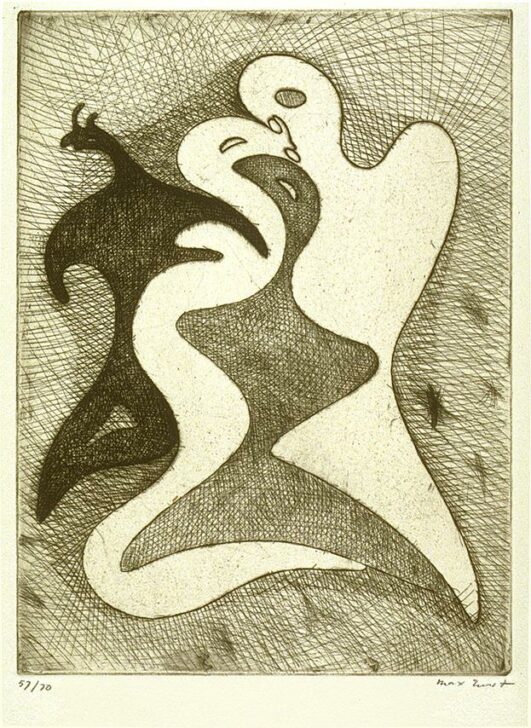Correspondances dangereuses
Brunidor Editions; Max Ernst; S. W. Hayter

Description
The Brunidor Portfolio No. One
At the request of art critic Nicholas Calas, seven Surrealist artists collaborated on a print portfolio published by Brunidor Editions, in New York, whose director was Robert Altmann. The artists were Max Ernst, Stanley William Hayter, Wifredo Lam, Matta, Joan Miró, Kurt Seligmann, and Yves Tanguy. The etchings were printed in Hayter’s Atelier 17, while the lithographs were pulled in the studio of Alfred Jones.
Calas’ introduction to the portfolio turned on the age-old controversy between line and color, in which line or form is seen as relating to thought, while color or light is considered pertinent to emotion. Excerpts from his essay, entitled "Saper Vedere" (To Know How to See), are given in italics in the labels accompanying each of the prints from the portfolio, all of which are exhibited here. Calas describes not only what these artists "see" with their imaginations, but also what he as a critic "sees" as he interprets the inherent meanings of these prints.
University of Michigan Museum of Art director Jean Paul Slusser in 1947 showed himself to be in the vanguard of contemporary trends in his recommendation that this portfolio be acquired in the very year it was published.
Midway between graphic and iconistic tendencies, simultaneously adhering and evading both, we find Max Ernst. Intent on artificializing nature until it produces pure resonance, he plays with biomorphic forms imagined and artificialized in myths during a bygone animistic and preadolescent era. . . . With Ernst one understands that as long as magic currents run through brain and hand there is no difference between the impression of the real and the rendering of the false.
Sometimes known as School for Birds (École d’Oiseaux), this etching employs variations on the curving form of the birds. Set against a dreamlike void of radiating and swirling hatching lines, the negative and positive interlocking shapes create a lively play as the forms overlap and fit against one another. Label copy from exhibition "Dreamscapes: The Surrealist Impulse," August 22 - October 25, 1998
Subject Matter:
This print is part of a portfolio published by Brunidor Editions, New York (the portfolio's namesake), at the request of art critic Nicholas Calas. It included seven prints from a number of prominent Surrealist artists, including: Robert Matta, Stanley William Hayter, Wifredo Lam, Joan Miró, Kurt Seligmann, and Yves Tanguy. Calas’ introduction to the portfolio turned on the age-old controversy between line and color, in which line or form is seen as relating to thought, while color or light is considered pertinent to emotion. Calas describes not only what these artists "see" with their imaginations, but also what he as a critic "sees" as he interprets the inherent meanings of these prints.
Ernst's contribution, plate two of seven, present typical motifs of bird-like figures in an embrace. After founding the short-lived Cologne Dada movement, he joined up with Surrealists, Paul Eluard and André Breton, in Paris. This work was produced in New York, where he settled until 1950, initally to escape the Nazi advance in Europe during the Second World War. Ernst had long used animalistic imagery, in particular birds, in his Surrealist works. For Ernst, images of birds reference his created symbol of "Loplop, superior of birds," who was able to present Ernst's Surrealist interpretations of the world. Correspondances dangereues is just one of a large number of works, like his 1942 Surrealism and Painting (Menil Collection, Houston), that depict the Loplop embracing another bird-like creature in a state of creation, a vision of a Freudian dream.
Physical Description:
At the center of the etching are three or four amorphous figures in white and two shades of black, made in crosshatching. The figures are entwined and have animal and bird-like features. The background is crosshatched to the edges of the page. The print is signed (l.r.) "Max Ernst" and numbered (l.l.) "57/70" in pencil.
Usage Rights:
If you are interested in using an image for a publication, please visit https://umma.umich.edu/request-image/ for more information and to fill out the online Image Rights and Reproductions Request Form.